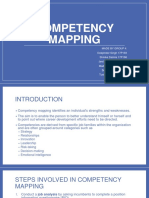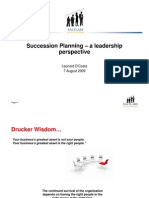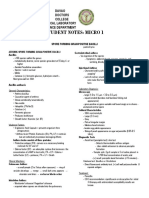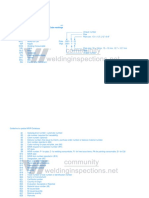Employee-Retention-Plan 1 185
Employee-Retention-Plan 1 185
Uploaded by
SamratCopyright:
Available Formats
Employee-Retention-Plan 1 185
Employee-Retention-Plan 1 185
Uploaded by
SamratOriginal Title
Copyright
Available Formats
Share this document
Did you find this document useful?
Is this content inappropriate?
Copyright:
Available Formats
Employee-Retention-Plan 1 185
Employee-Retention-Plan 1 185
Uploaded by
SamratCopyright:
Available Formats
Employee Retention Plan
How To
Create Your
Retention Plan
Using simple strategies to
persuade employees to stay
Introduction
This guide is designed to help you create an employee retention plan that
will work in practice, rather than one that looks good on paper but fails to
persuade employees from leaving.
A retention plan is simply a list of those actions you intend to take to
increase your chances of retaining targeted employees; a proactive
approach to retention as opposed to the common, passive, and at times
negligent, assumption that employees will stay.
The most effective retention plans, are deceptively simple in their
construction. But they are based on sound principles, on an
understanding of what really makes a difference to employees, especially
those employees whose departure could be avoided.
In essence, you decide which employees you wish to retain, your targets,
or top priorities. Then you determine the most appropriate way to
persuade them to stay.
http://www.employee-retention-guide.com
Employee Retention Plan
Retention Plan Background
A sensible retention plan includes two elements. One that focuses on the
retention of established employees and another that tackles early turnover
departures in the first six months.
The problem with many retention efforts is that they are too general, not
targeted, and unfortunately, not relevant to many of the employees they
wish to influence.
The best approach to meeting the challenge of retaining employees is to
reduce the appeal of competitors by creating value; value that is
determined by the employee. And to do so you need to know what is
important to each individual employee you wish to retain.
Why People Leave
The key drivers of employee turnover can be divided into two categories:
push factors and pull factors. While some perfectly satisfied employees
may be tempted away by the pull of an offer so fantastic that they just
have to accept, the large majority of departures do involve an element of
push.
It is a mistake to assume that all departures occur for the same reasons.
One persons priorities may not match anothers. There may be
considerable differences in what different employees are prepared to
tolerate before they start looking elsewhere.
There are surveys and studies that detail the most common push factors
such as poor people management, and a lack of career development
opportunities but these are rarely the only push factors in play.
A retention plan must take into consideration the relevant push factors
and find a way to minimise their effect. A good starting point is discovering
what they are. A sensible approach to adopt is described below.
http://www.employee-retention-guide.com
Employee Retention Plan
1. Retaining Current Employees
When it comes to retaining current employees, the latest research shows
that two interrelated retention strategies outperform all others by a
considerable margin. Firms are strongly advised to adopt these measures.
The first relates to the assessment and reward of managers. The second
to the use of periodic retention focused interviews. Both are described in
detail below.
Managers are the linking factor between the two strategies and their role
is a vital one if the plan is to succeed. Without the support of managers
many a retention strategy that looked good on paper has failed to deliver
in practice.
Other measures may be applicable in certain circumstances. It is
important to take note of the destinations of departing employees. It may
be that employees are leaving to join indirect competitors for their services
rather than traditional rivals.
Understanding the appeal of the real competition is a vital element of any
retention effort. This can be done on a micro or macro basis though it is
wise to recognise that it is the individual that makes the decision to leave
and their criteria are what really matters.
Employee attitude surveys will sometimes provide valuable insight with
regards to turnover. However, it has to be said that there are serious
reliability issues with both surveys and exit interviews.
Where additional employee insight is needed, the nominative group
technique is to be recommended. This form of focus group is especially
appropriate for diagnosing the causes of turnover within different groups.
http://www.employee-retention-guide.com
Employee Retention Plan
a) Managers, Managing And Employee Retention
To increase the chances of your managers acting as retention magnets,
as opposed to being one of main drivers of employee turnover, you
should take the following proactive steps.
Give Managers The Responsibility For Tackling Turnover
Make clear to managers the costs involved each time someone leaves
and the benefits associated with low rates of turnover. Explain the loyalty
effect described by Frederic Reichheld and how it applies to your
situation. Agree the length of time you expect employees to stay with the
company. Then set appropriate targets.
Assess Managers On Turnover Figures
Include employee turnover amongst the figures on which managers are
assessed. Be careful to use benchmarks that are fair and targets that are
realistic. Use a definition of turnover that does not include retirements,
redundancies and dismissals.
Reward Managers On Their Retention Achievements
Create a link between managers bonuses and their retention
achievements.
Provide Appropriate Support To Managers
This will depend upon circumstances, something as simple as an hour of
coaching each month for a period of six months will often be sufficient.
Alternatively, you might provide an opportunity for managers to meet
periodically to discuss their successes and the challenges they are
currently facing.
Talentkeepers have produced a fairly comprehensive internet based
retention product for managers that may be appropriate for those that
http://www.employee-retention-guide.com
Employee Retention Plan
wish to devote considerable time and energy to developing their skills in
this area.
Consider Upward Feedback
The use of upward feedback can assist managers to improve their people
management skills.
Some work environments may not be suit the introduction of such an idea.
As with 360 degree feedback there are times and places where its impact
is minimal at best.
As an alternative to assessing managers on turnover figures, you can use
an indirect approach and assess them on their ability as a developer of
people.
http://www.employee-retention-guide.com
Employee Retention Plan
b) Retention Interviews
The second element recommended by the research for the retention of
current employees is the introduction of periodic retention focused
interviews.
If you want to retain someone, you can improve your chances by being
proactive, by making the first move before they start to look elsewhere, or
receive a tempting offer from one of your competitors.
Some departures are unavoidable, but not all. If you ask people why they
left you find that many of the reasons could have been avoided given
better communication, given a degree of flexibility, some imagination, and
a willingness to negotiate.
The purpose behind retention interviews is to encourage employees to
explain their aspirations, their needs, their preferences what needs to be
done for them to stay. Without this information it is easy for a firm to lose
talented employees for avoidable reasons.
In retention it is often the small change that makes the difference. But it
needs to be a change that is relevant to the individual, a change that is of
value to them.
So roles are customized, tailored to suit the individual, small adjustments
that might seem irrelevant to an outsider.
Retention interviews have been shown to reduce the number of avoidable
departures. Loyalty should not be taken for granted. The relative
attractiveness of competitors and other options can be reduced by a few
small changes.
http://www.employee-retention-guide.com
Employee Retention Plan
Depending on the precise circumstances, some of the things you might
like to discuss are:
Career development plans
Recognition of their contribution
Work assignments
Job sculpting
Coaching
Work-life balance
Ask people to stay
Of course, there are parameters, boundaries you cannot cross. Some
changes just arent possible. But you could always ask if there is anything
else that is important to them.
Format
The best format to adopt is the deceptively simple ask, listen, negotiate.
So the manager might ask about the employees career aspirations, then
discuss practical changes they could make that would assist the
employee in gaining some of the skills and experiences they need to
reach their ultimate destination.
These changes might involve additional training, some coaching, new
responsibilities or particular work assignments.
http://www.employee-retention-guide.com
Employee Retention Plan
Questions
What are your career aspirations?
What can we do to assist?
What do you want to do next?
What will keep you here?
What is the best thing about your role?
What is the worst?
What can we do to make your job more rewarding?
We want to retain you, what will it take?
What is most important to you?
What single change would you make to your role?
Careers And Aspirations
Once you know an employees career aspirations, you are in a much
stronger position to retain them. An employee will often be happy to stay if
they feel their employer or manager has their best interests at heart.
You can create value for employees by supporting growth, by helping
them improve their current skills and develop new ones; preparing them
for the future.
Careers Development Plan
If the future doesnt get discussed, it can be easy for employees assume,
rightly or wrongly, that their future must lie beyond the firm. That the firm
isnt really bothered whether they stay or go. So they look to move on.
http://www.employee-retention-guide.com
Employee Retention Plan
During the retention interview, or perhaps at a later date, you might want
to spend a few minutes co-creating a career development plan. Be a
catalyst. Help them to think about their unique talents, their interests, their
skills.
Discuss trends, business needs, challenges and the future. Where will the
opportunities arise? What skills will be needed?
Flexibility
A flexible manager is far more likely to be able to retain employees than a
manager with a more rigid approach.
A manager that is assessed, and rewarded, on their ability to retain
employees, will often be more willing to negotiate a mutually agreeable
solution.
http://www.employee-retention-guide.com
Employee Retention Plan
2. Eliminate Unnecessary Early Turnover
Departures that occur within the first six months of joining the company
will tend to be a result of failings in either the recruitment or orientation
processes. Fortunately, these are easy to remedy.
Realistic Job Previews
Make every effort to provide a realistic job preview in order to reduce the
element of surprise. All too often new employees leave after a few weeks
when they discover the job was not as they expected.
Adverts designed to show the company in its best light may attract
superior candidates, but giving a misleading impression of the daily reality
of the role is likely to be a costly mistake.
Expectations
A major flaw in many recruitment processes is the failing to address the
issue of expectations. It is very easy for an individual to assume that
things will be similar to their previous place of work. But not all these
assumptions turn out to be correct.
Spending as little as 10 minutes discussing expectations, both those of
the candidate, and those of the firm, can reduce early turnover by as
much as 20%, sometimes more.
Clarify promotion prospects, especially time frames, salary and bonus
arrangements, working hours and location flexibility, managerial style and
approach to assessment.
Attempt, wherever possible, to get a sense of the candidates medium to
long-term career goals and aspirations. Be careful not to appoint
someone who will outgrow the position in a very short space of time
unless you intend to promote them almost immediately.
10
http://www.employee-retention-guide.com
Employee Retention Plan
Extreme Caution
Be careful about recruiting employees who will have to relocate. There is
a high risk that factors beyond the workplace will result in an early
departure.
Think twice before appointing candidates with high potential. A fairly
common error in recent years has been for firms to select graduate calibre
candidates into roles with limited room for growth. Is this person likely to
be content to perform the role in question for the length of time the
company desires?
Promote From Within
Internal promotions have a far greater success rate than external hiring
when judged on retention rates; there are fewer surprises, the risk is
lower. Of course, there are many other factors that need to be taken into
consideration when determining who to appoint.
Orientation
In recent years firms have been paying more attention to the orientation
process. And some have been able to reduce early turnover as a direct
consequence.
On their first few days new recruits are bound to feel slightly lost,
confused, out of place. Not sure what the rules are, who to talk to. They
may decide they prefer their old job with its comfortable routine, their
friends, emotional attachments.
From a retention perspective orientation, or on-boarding, has to achieve
one thing: to get the new employee to feel at home as quickly as possible.
Does your current process meet this requirement?
If you arent sure, try asking current employees how long it took them to
feel settled, and what might have been done better during their first month
or so.
11
http://www.employee-retention-guide.com
Employee Retention Plan
Common mistakes during this period:
Not having the new employee's equipment in place
Ignoring them or leaving them to read manuals
Long lectures, too much information, endless form filling
Not involving the new recruit's manager and department
Monologue rather than dialogue
Instead try to:
Make sure equipment is in position
Show them how they can achieve
Explain what is expected of them
Explain how to add value
Explain how to be a team player
Help them to feel at home
The current fashion seems to be to adopt a buddy scheme, pairing each
newcomer with someone who will look after them for the first few months,
showing them how things work, explaining the unwritten rules and
providing answers to the many questions they are likely to have during
this period.
Inevitably the manager or supervisor of the new recruit will play a major
role in their orientation. From a retention perspective there are two
priorities: firstly, explaining the importance of their role in the success of
the business, and secondly, to ask the employee to promise that they will
come and talk to the manager before deciding to leave the company.
12
http://www.employee-retention-guide.com
Employee Retention Plan
Apart from the usual tasks such as introducing the new recruit to other
team members, briefing them on the company strategy, objectives and
values, discovering how they prefer to be managed and motivated, the
main focus should be on getting them in position so they can contribute as
quickly as possible.
Get them started so they can make a real contribution
Schedule any training they might need
Give them an appropriate assignment not too difficult,
not too simple
Establish medium term goals including both personal
and career development goals
Arrange short meetings to check how they are doing
Get colleagues to meet them to explain how best to
communicate
Invite them to the next social event
Colin Brown 2006
13
http://www.employee-retention-guide.com
You might also like
- NEW 3CO02 - June 2023-Sept 2024 Student Assignment.No ratings yetNEW 3CO02 - June 2023-Sept 2024 Student Assignment.15 pages
- Methods For Collecting Job Analysis InformationNo ratings yetMethods For Collecting Job Analysis Information9 pages
- Creating A Leadership Development ProgramNo ratings yetCreating A Leadership Development Program15 pages
- Chapter 10. Managing Careers and RetentionNo ratings yetChapter 10. Managing Careers and Retention35 pages
- Learning-And-Development-Policy-Oct-2020 LinkNo ratings yetLearning-And-Development-Policy-Oct-2020 Link16 pages
- Training Needs Assessment: Syed Arsalan Ali 8990 BBA (H)No ratings yetTraining Needs Assessment: Syed Arsalan Ali 8990 BBA (H)15 pages
- Learning & Development Strategy 2011 - 2014: Background and IntroductionNo ratings yetLearning & Development Strategy 2011 - 2014: Background and Introduction5 pages
- Learn Implement Accelerate: Phase 1 Phase 2 Phase 3No ratings yetLearn Implement Accelerate: Phase 1 Phase 2 Phase 32 pages
- The Five Most Important Tips For Effective RecognitionNo ratings yetThe Five Most Important Tips For Effective Recognition4 pages
- Best Practices in Highly Functioning Recruiting Departments100% (1)Best Practices in Highly Functioning Recruiting Departments7 pages
- Succession Planning - A Leadership Ti Perspective: Saltlabs100% (1)Succession Planning - A Leadership Ti Perspective: Saltlabs20 pages
- ExeQserve Service Culture Building ProgramNo ratings yetExeQserve Service Culture Building Program13 pages
- HR Audit at HCL: Submitted by-SRISHTI BHATEJA (19021141116)No ratings yetHR Audit at HCL: Submitted by-SRISHTI BHATEJA (19021141116)8 pages
- Report On Recruitment Process: Submitted byNo ratings yetReport On Recruitment Process: Submitted by7 pages
- Approaches To Business Process Analysis - Biazzo 2000No ratings yetApproaches To Business Process Analysis - Biazzo 200014 pages
- The Comprehensive Guide To Succession PlanningNo ratings yetThe Comprehensive Guide To Succession Planning11 pages
- Training Programme Evaluation of The Scribd HR Training and Development100% (1)Training Programme Evaluation of The Scribd HR Training and Development14 pages
- Integrating HR & Talent Management Processes: Succession Planning100% (1)Integrating HR & Talent Management Processes: Succession Planning10 pages
- Unit 8 Human Resources Learning Aim AB Assignment BriefNo ratings yetUnit 8 Human Resources Learning Aim AB Assignment Brief3 pages
- Total Quality Management-Leadership: Presented By, Shivakumar Merrin Syra Rahana RasheedNo ratings yetTotal Quality Management-Leadership: Presented By, Shivakumar Merrin Syra Rahana Rasheed29 pages
- A Study On Recuritment at Axiom TechnologiesNo ratings yetA Study On Recuritment at Axiom Technologies7 pages
- Planning Conducting Interview GuidelinesNo ratings yetPlanning Conducting Interview Guidelines10 pages
- Q1) What Is Mean, Covariance, Variance and Correlation Coefficient?No ratings yetQ1) What Is Mean, Covariance, Variance and Correlation Coefficient?5 pages
- Organizat Ional Behavior: - Improving PerformanceNo ratings yetOrganizat Ional Behavior: - Improving Performance18 pages
- Green and Blue Illustrative Technology Product Development PresentationNo ratings yetGreen and Blue Illustrative Technology Product Development Presentation10 pages
- Failure of TRLY and TREG Card in MARK VI-OCT09pdf PDFNo ratings yetFailure of TRLY and TREG Card in MARK VI-OCT09pdf PDF5 pages
- Implicit & Explicit Finite Element Analysis - CAE ANALYSISNo ratings yetImplicit & Explicit Finite Element Analysis - CAE ANALYSIS2 pages
- A Study of Bachat Gat & Women Empowerment in Nagpur City: October 2019No ratings yetA Study of Bachat Gat & Women Empowerment in Nagpur City: October 20195 pages
- Student Notes: Micro 1: Davao Doctors College Medical Laboratory Science DepartmentNo ratings yetStudent Notes: Micro 1: Davao Doctors College Medical Laboratory Science Department5 pages
- CBSE Notes Class 6 History Chapter 1 - What, Where, How and When?No ratings yetCBSE Notes Class 6 History Chapter 1 - What, Where, How and When?3 pages
- Chapter 14: Acute Respiratory Failure Test Bank: Multiple ChoiceNo ratings yetChapter 14: Acute Respiratory Failure Test Bank: Multiple Choice13 pages
- Photo Warehouse Film Development Chart Push Processing (B/W)No ratings yetPhoto Warehouse Film Development Chart Push Processing (B/W)1 page
- Fou105 Business Communication 2019-20 TRIMESTER 2: Assessment 1: Learning Portfolio Learning Portfolio 3 GuideNo ratings yetFou105 Business Communication 2019-20 TRIMESTER 2: Assessment 1: Learning Portfolio Learning Portfolio 3 Guide2 pages
- The Beautiful and Damned (F. Scott Fitzgerald) (Z-Library)No ratings yetThe Beautiful and Damned (F. Scott Fitzgerald) (Z-Library)450 pages
- VD2103-FIT-ME-QCP-E02-0013-02 - RO ERD Racks Quality Control PlanNo ratings yetVD2103-FIT-ME-QCP-E02-0013-02 - RO ERD Racks Quality Control Plan2 pages
- Green Buildings, Organizational Success, and Occupant Productivity (Heerwagen, 2000)No ratings yetGreen Buildings, Organizational Success, and Occupant Productivity (Heerwagen, 2000)21 pages
- NEW 3CO02 - June 2023-Sept 2024 Student Assignment.NEW 3CO02 - June 2023-Sept 2024 Student Assignment.
- Training Needs Assessment: Syed Arsalan Ali 8990 BBA (H)Training Needs Assessment: Syed Arsalan Ali 8990 BBA (H)
- Learning & Development Strategy 2011 - 2014: Background and IntroductionLearning & Development Strategy 2011 - 2014: Background and Introduction
- Learn Implement Accelerate: Phase 1 Phase 2 Phase 3Learn Implement Accelerate: Phase 1 Phase 2 Phase 3
- The Five Most Important Tips For Effective RecognitionThe Five Most Important Tips For Effective Recognition
- Best Practices in Highly Functioning Recruiting DepartmentsBest Practices in Highly Functioning Recruiting Departments
- Succession Planning - A Leadership Ti Perspective: SaltlabsSuccession Planning - A Leadership Ti Perspective: Saltlabs
- HR Audit at HCL: Submitted by-SRISHTI BHATEJA (19021141116)HR Audit at HCL: Submitted by-SRISHTI BHATEJA (19021141116)
- Approaches To Business Process Analysis - Biazzo 2000Approaches To Business Process Analysis - Biazzo 2000
- Training Programme Evaluation of The Scribd HR Training and DevelopmentTraining Programme Evaluation of The Scribd HR Training and Development
- Integrating HR & Talent Management Processes: Succession PlanningIntegrating HR & Talent Management Processes: Succession Planning
- Unit 8 Human Resources Learning Aim AB Assignment BriefUnit 8 Human Resources Learning Aim AB Assignment Brief
- Total Quality Management-Leadership: Presented By, Shivakumar Merrin Syra Rahana RasheedTotal Quality Management-Leadership: Presented By, Shivakumar Merrin Syra Rahana Rasheed
- Q1) What Is Mean, Covariance, Variance and Correlation Coefficient?Q1) What Is Mean, Covariance, Variance and Correlation Coefficient?
- Green and Blue Illustrative Technology Product Development PresentationGreen and Blue Illustrative Technology Product Development Presentation
- Failure of TRLY and TREG Card in MARK VI-OCT09pdf PDFFailure of TRLY and TREG Card in MARK VI-OCT09pdf PDF
- Implicit & Explicit Finite Element Analysis - CAE ANALYSISImplicit & Explicit Finite Element Analysis - CAE ANALYSIS
- A Study of Bachat Gat & Women Empowerment in Nagpur City: October 2019A Study of Bachat Gat & Women Empowerment in Nagpur City: October 2019
- Student Notes: Micro 1: Davao Doctors College Medical Laboratory Science DepartmentStudent Notes: Micro 1: Davao Doctors College Medical Laboratory Science Department
- CBSE Notes Class 6 History Chapter 1 - What, Where, How and When?CBSE Notes Class 6 History Chapter 1 - What, Where, How and When?
- Chapter 14: Acute Respiratory Failure Test Bank: Multiple ChoiceChapter 14: Acute Respiratory Failure Test Bank: Multiple Choice
- Photo Warehouse Film Development Chart Push Processing (B/W)Photo Warehouse Film Development Chart Push Processing (B/W)
- Fou105 Business Communication 2019-20 TRIMESTER 2: Assessment 1: Learning Portfolio Learning Portfolio 3 GuideFou105 Business Communication 2019-20 TRIMESTER 2: Assessment 1: Learning Portfolio Learning Portfolio 3 Guide
- The Beautiful and Damned (F. Scott Fitzgerald) (Z-Library)The Beautiful and Damned (F. Scott Fitzgerald) (Z-Library)
- VD2103-FIT-ME-QCP-E02-0013-02 - RO ERD Racks Quality Control PlanVD2103-FIT-ME-QCP-E02-0013-02 - RO ERD Racks Quality Control Plan
- Green Buildings, Organizational Success, and Occupant Productivity (Heerwagen, 2000)Green Buildings, Organizational Success, and Occupant Productivity (Heerwagen, 2000)






























































































